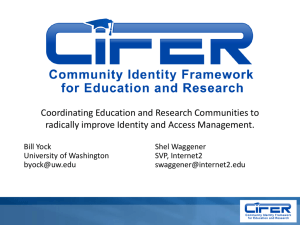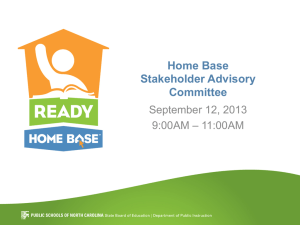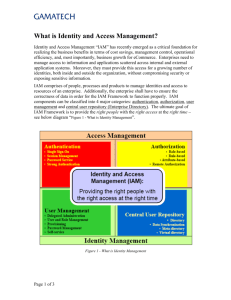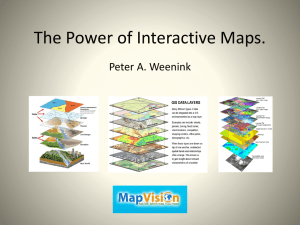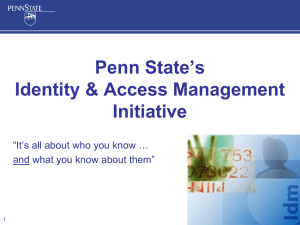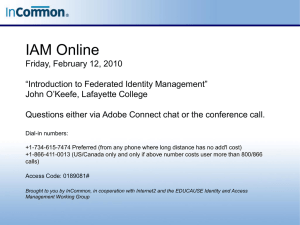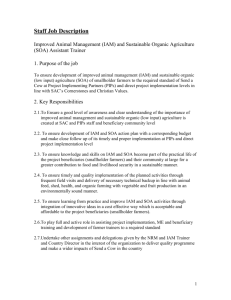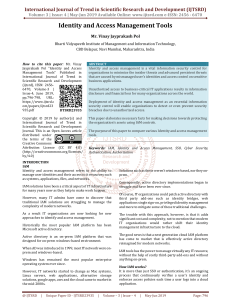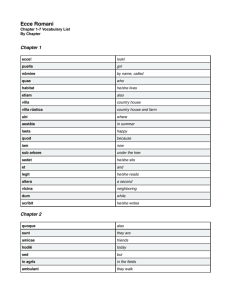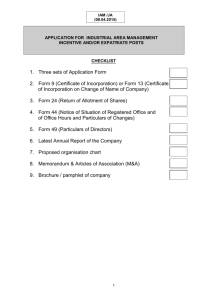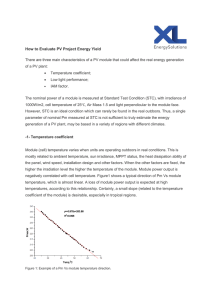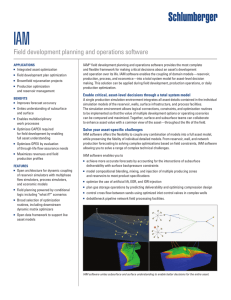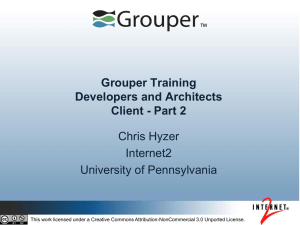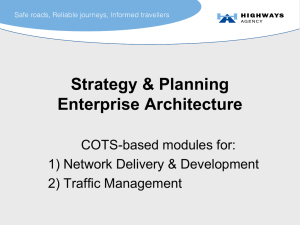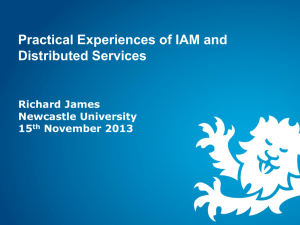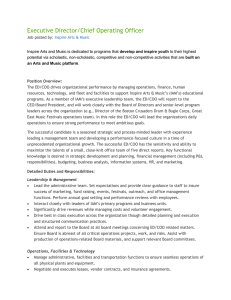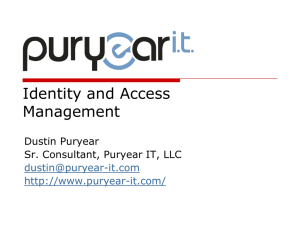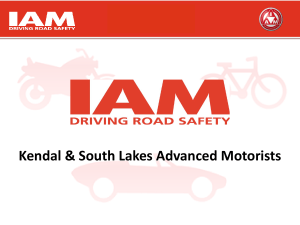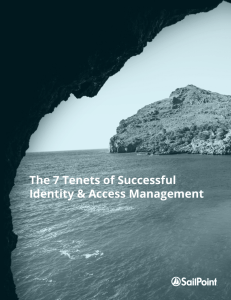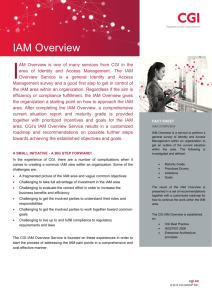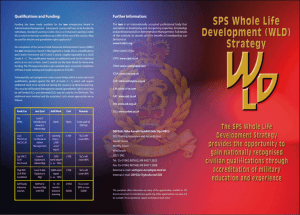IAM Overview and Self
advertisement
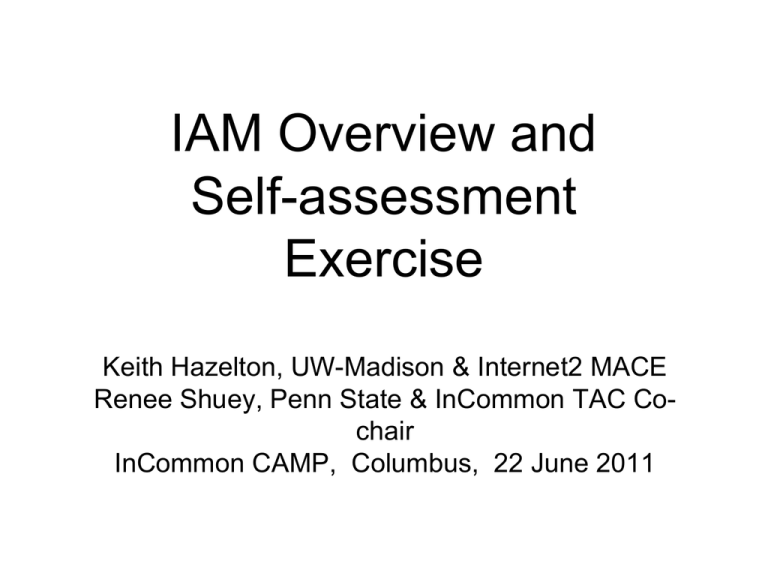
IAM Overview and Self-assessment Exercise Keith Hazelton, UW-Madison & Internet2 MACE Renee Shuey, Penn State & InCommon TAC Cochair InCommon CAMP, Columbus, 22 June 2011 Who is IAM? • • • • • • • • • • • • • Access to Protected Library Resources Library Staff Access to Integrated Library System Access to Library Public Workstations HMC Affiliate Access to Library Resources Access to Alumni Library Resources Access to Electronic Theses and Dissertations Web Site Graduate School Exit Survey Federating to blogging hosted Services Prospective students applying for financial aid Employee Confidentiality Provisioning of an employee's digital Identity Student early access to residence hall requests and immunization records submissions Grouper Auditing Use Case • • • • • • • • • • • Continuing Education and Adult Students New Students Applying for Admissions and Oncampus Housing Prospective Students Visiting Penn State New Kensington New Faculty and Access to ANGEL and Other Class Resources Adjunct Faculty Activating Access Account New Faculty & Staff Selecting Benefits Terminated Faculty Member Maintains Access Physicians at the Hershey Medical Center and Access to Library Resources Patients, Family Members, and Visitors at the Penn State Hershey Medical Center Alumni Donors Alumni Association • • • • • • • • • • • • • • • • Local Community Member and Short Term Access Accounts Registrar Relationships Student Lifecycle New Students Applying for Undergraduate Admissions Provision of Access to Course Work For Students at a Distance Library Resources ITS Computer Store Access CIC CourseShare Deprovision User content after graduation or resignation Google Cache Updates Access to user content after graduation and or resignation Access to directory data Emergency Rehire Mulitple IDs Deceased Employee Outreach Registration process • • • • • • • • • • • • • • • Updating ISIS Security Profile Multiple Security Realms, Same Userids but Different Passwords ROTC Instructor Affiliation Instructor with Independent Contractor Status Name change switching in the directory Special Affiliates (for example Religious Affiliates) Father and son who is a JR Cloning ISIS Security Profiles New PSUid assigned for new PSU affiliation Student Football Tickets Department Identity DSL Use Case Interview Police Services Use Case Interview Police Services Use Case Police Log What is IAM? “….it is the alignment of University business processes, policies, and tec hnologies that manage identities to support the delivery of rich and diverse array of online s ervices for faculty, staff, and students….” Why IAM? • Consolidation of multiple identity stores • Simplify process for user’s to manage identity information • Mitigate Risk • Provide flexibility to move to a more user centric IdM Identity and Access Management Infrastructure Big Picture Foundational Identity Management Identity and Access Management Group and Role Management Privilege Management Identity and Access Management The Rest of the Story Governance • • Resolve conflicts, make decisions at the institutional level Attributes for Success: • • • Sustained lateral awareness of needs, challenges for the purposes of anticipating collisions before they happen Recognizing what is possible and what we’re striving for Processes to make decisions when conflicts arise Governance • • • People own their identity Within the institution, units/executives are stewards for a context Those contexts overlap in complicated, significant ways Governance • What Kinds of Decisions • • • Methods, processes to resolve conflicts Policy recommendations, changes, development Set direction for process and technology requirements Policy • The establishment and adoption of policy is a key component to the success of an Identity and Access Management (IAM) implementation. • “P”olicy vs. “p”olicy Policy - One Approach The State of Identity Management Self-assessment Questionnaire External Collaboration Collaboration with other institutions and entities beyond our own is rare or non-existent. 1 2 There is some ad-hocCollaboration beyond our institution is a collaboration with key component to our educational and institutions and research missions. entities beyond or own. 3 4 5 6 7 8 9 10 Security of Identities and Authentication We are comfortable permitting vendor access to BOTH our identity information AND authentication information. 1 2 3 4 We are comfortable permitting vendor access to EITHER identity information OR authentication information. 5 6 7 We are not comfortable releasing ANY authentication information and only releasing MINIMAL identity information to the vendor. 8 9 10 entities We do not have a centrally supported guest login. This brings weakly identified people into our identity management system that are poorly tracked and managed over time. 1 2 3 4 There is some ad-hoc collaboration with institutions and entities beyond or own. 5 6 7 Collaboration beyond our institution is a key component to our educational and research missions. 8 9 10 Integration technologies We gather information from sources with a mix of flat file transfer, reports, direct SQL access, and/or email. 1 2 3 We rely on batch We have realtime access to processes but use data, e.g., through LDAP, as consistent techniques with well as an enterprise, our clients and a common message-based integration secured infrastructure. infrastructure. 4 5 6 7 8 9 10 Process Our processes are manual, ad-hoc, and not documented or well understood. 1 2 3 We have a mix of formal Our processes are processes and those established, automated, and created on an as-needed documented. basis. Some are automated and some are not. 4 5 6 7 8 9 10 Account de-Provisioning process There is little connection between central IT support for core infrastructure and business systems, and distributed school or departments system. There means many independently maintained shadow systems with poor data sharing and little automated updates from common sources. 1 2 3 4 We can make data available, through reports or directory lookups to more directly enable local systems, but actual reuse is inconsistent across campus. 5 6 7 We support collaborative work in schools and departments by enabling them to define and share information and privileges on their own. It is easy to access common enterprise data, either for realtime reference or for ongoing synchronization. 8 9 10 consistency IT staff may find themselves Policies providing a Business units base access making access management framework for consistent management decisions on decisions where business rules access management policies and the decisions are in classification of the data don’t exist and no decisionmaking body exists. development or in place. being protected. 1 2 3 4 5 6 7 8 9 10 Practices Our practices are ad-hoc at best. 1 2 3 We have a mix of formal Our practices are established practices and those and publicly posted. created on an as-needed basis 4 5 6 7 8 9 10 Self Assessment Group Exercise ~30 Minutes Additional Resources • InCommon • http://www.incommonfederation.org/ • EDUCAUSE IdM • http://www.educause.edu/iam • Grouper • http://www.internet2.edu/grouper/ • PACCMAN • http://middleware.internet2.edu/pacc
